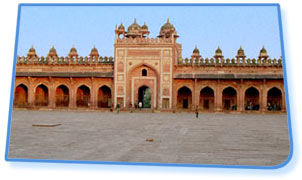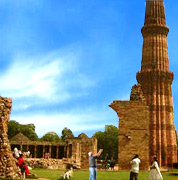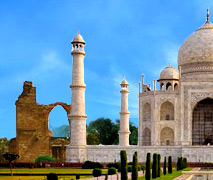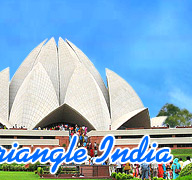 40
km from Agra, the city of Fatehpur Sikri served as the capital of the
Mughal Empire between 1570 and 1586. But as abruptly as it had been
built, it was abandoned due to the scarcity of water. A popular legend
is attached to the city's conception. According to it, Emperor Akbar was
without a male heir, and was granted one by the blessings of the Sufi
saint Sheikh Salim Chisti. In honor of the saint, Akbar named the prince
Salim, and decided to found a new city to celebrate his birth. And thus,
the magnificent Fatehpur Sikri, the new capital, came into being. The
city was intended to embody the noble ideals, and the humanitarian bent
of this dynamic emperor. The finest monuments within this area are the
Diwan - i - Am, Diwan - i - Khas, Panch Mahal, Jama Masjid, Panch Mahal,
Buland Darwaza and the tomb of Saint Sheikh Salim Chisti.
40
km from Agra, the city of Fatehpur Sikri served as the capital of the
Mughal Empire between 1570 and 1586. But as abruptly as it had been
built, it was abandoned due to the scarcity of water. A popular legend
is attached to the city's conception. According to it, Emperor Akbar was
without a male heir, and was granted one by the blessings of the Sufi
saint Sheikh Salim Chisti. In honor of the saint, Akbar named the prince
Salim, and decided to found a new city to celebrate his birth. And thus,
the magnificent Fatehpur Sikri, the new capital, came into being. The
city was intended to embody the noble ideals, and the humanitarian bent
of this dynamic emperor. The finest monuments within this area are the
Diwan - i - Am, Diwan - i - Khas, Panch Mahal, Jama Masjid, Panch Mahal,
Buland Darwaza and the tomb of Saint Sheikh Salim Chisti.40 km from Agra, the city of Fatehpur Sikri served as the capital of the Mughal Empire between 1570 and 1586
Golden Triangle India » Places to see » Fatehpur Sikri
Fatehpur Sikri
Fatehpur Sikri
 40
km from Agra, the city of Fatehpur Sikri served as the capital of the
Mughal Empire between 1570 and 1586. But as abruptly as it had been
built, it was abandoned due to the scarcity of water. A popular legend
is attached to the city's conception. According to it, Emperor Akbar was
without a male heir, and was granted one by the blessings of the Sufi
saint Sheikh Salim Chisti. In honor of the saint, Akbar named the prince
Salim, and decided to found a new city to celebrate his birth. And thus,
the magnificent Fatehpur Sikri, the new capital, came into being. The
city was intended to embody the noble ideals, and the humanitarian bent
of this dynamic emperor. The finest monuments within this area are the
Diwan - i - Am, Diwan - i - Khas, Panch Mahal, Jama Masjid, Panch Mahal,
Buland Darwaza and the tomb of Saint Sheikh Salim Chisti.
40
km from Agra, the city of Fatehpur Sikri served as the capital of the
Mughal Empire between 1570 and 1586. But as abruptly as it had been
built, it was abandoned due to the scarcity of water. A popular legend
is attached to the city's conception. According to it, Emperor Akbar was
without a male heir, and was granted one by the blessings of the Sufi
saint Sheikh Salim Chisti. In honor of the saint, Akbar named the prince
Salim, and decided to found a new city to celebrate his birth. And thus,
the magnificent Fatehpur Sikri, the new capital, came into being. The
city was intended to embody the noble ideals, and the humanitarian bent
of this dynamic emperor. The finest monuments within this area are the
Diwan - i - Am, Diwan - i - Khas, Panch Mahal, Jama Masjid, Panch Mahal,
Buland Darwaza and the tomb of Saint Sheikh Salim Chisti.
 40
km from Agra, the city of Fatehpur Sikri served as the capital of the
Mughal Empire between 1570 and 1586. But as abruptly as it had been
built, it was abandoned due to the scarcity of water. A popular legend
is attached to the city's conception. According to it, Emperor Akbar was
without a male heir, and was granted one by the blessings of the Sufi
saint Sheikh Salim Chisti. In honor of the saint, Akbar named the prince
Salim, and decided to found a new city to celebrate his birth. And thus,
the magnificent Fatehpur Sikri, the new capital, came into being. The
city was intended to embody the noble ideals, and the humanitarian bent
of this dynamic emperor. The finest monuments within this area are the
Diwan - i - Am, Diwan - i - Khas, Panch Mahal, Jama Masjid, Panch Mahal,
Buland Darwaza and the tomb of Saint Sheikh Salim Chisti.
40
km from Agra, the city of Fatehpur Sikri served as the capital of the
Mughal Empire between 1570 and 1586. But as abruptly as it had been
built, it was abandoned due to the scarcity of water. A popular legend
is attached to the city's conception. According to it, Emperor Akbar was
without a male heir, and was granted one by the blessings of the Sufi
saint Sheikh Salim Chisti. In honor of the saint, Akbar named the prince
Salim, and decided to found a new city to celebrate his birth. And thus,
the magnificent Fatehpur Sikri, the new capital, came into being. The
city was intended to embody the noble ideals, and the humanitarian bent
of this dynamic emperor. The finest monuments within this area are the
Diwan - i - Am, Diwan - i - Khas, Panch Mahal, Jama Masjid, Panch Mahal,
Buland Darwaza and the tomb of Saint Sheikh Salim Chisti.











